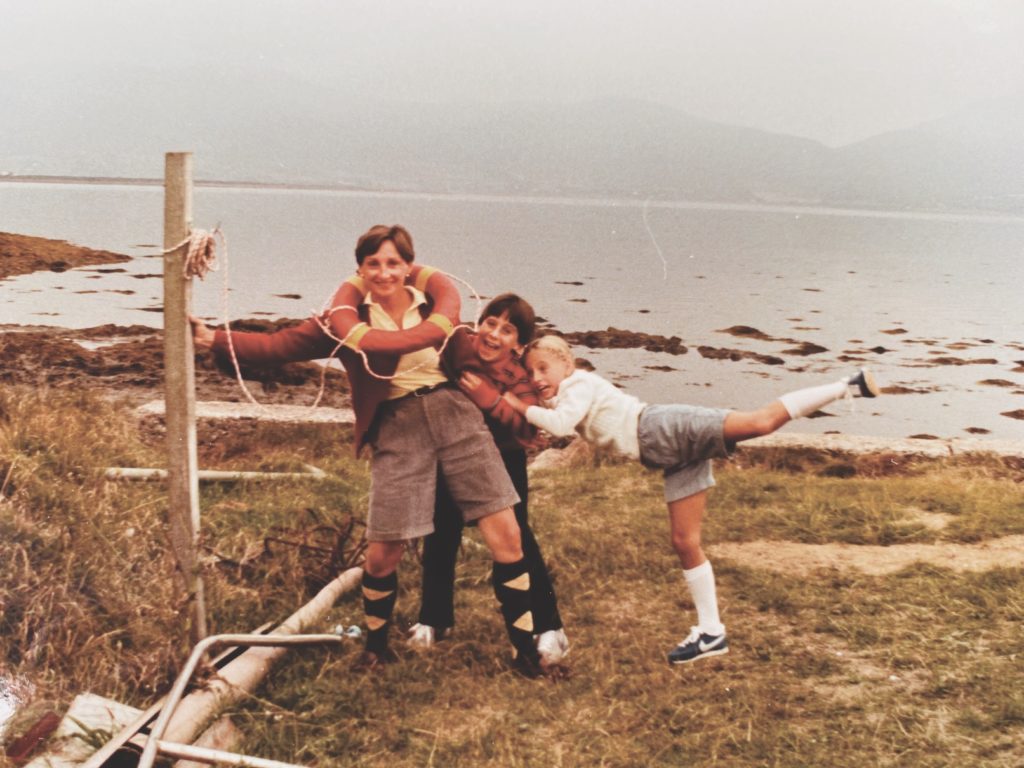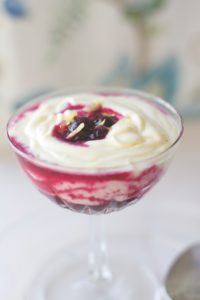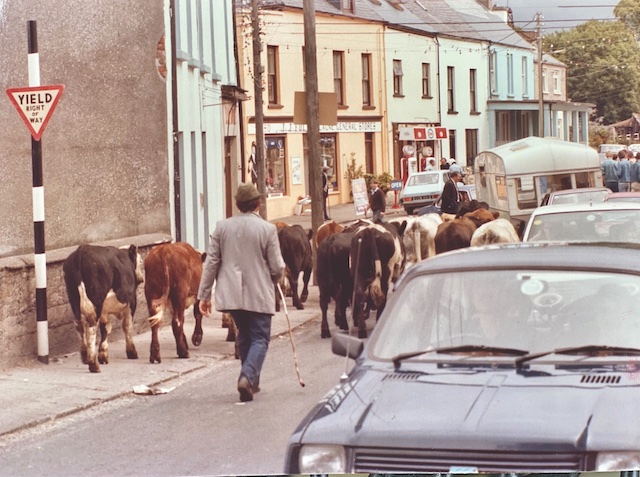For hundreds of years, Fair Day was an integral part of Ireland’s rural community, writes Margaret M. Johnson.
The holding of country fairs in rural Ireland goes back so far into the past that their beginnings are delightfully entangled in myth, history and tradition. Whether originally a pagan ritual or an occasion for farmers to sell surplus crops, the country fair has survived, even flourished, and is very much a part of the Irish summer calendar.
When I first visited Ireland in 1984, I planned our itinerary to be in Killorglin, County Kerry, for at least one of the days of August 10, 11, or 12 for the PUCK FAIR, a name I had heard my grandmother mention. She grew up in Rathmore, east of Killarney, and often spoke of “going to fair” as the highlight of her summer. When we visited, my children, 9 and 7 at the time, were gobsmacked by the cows that slowed traffic on the road from Cromane into Killorglin and wide-eyed when the animals brushed by our car close enough to touch. They were thrilled at the carnival atmosphere of the fair, the bumper cars, carousel rides, and the big goat perched high above the square. My husband developed an appetite for pints of Guinness at pubs named Donahoe’s, McCarthy’s, and Hennessy’s – but only to wash down the cheese toasties and bags of Taytos, he claimed! I was content just to be in Ireland to soak up its history and heritage and to chat with the locals.
But back to the goat. . .
King Puck, the great male goat that presides over the festivities at this well-known event, is bound up with pre-Christian rites of harvest and fertility. Most agree that there’s been a puck fair in many different guises since those time-shrouded days.
In 1613, Jenkin Conway, a local landowner, received a royal patent to “hold a fair in Killorglin on Lammas Day (August 1) and the day after.” Another local landowner, is said to have introduced King Puck to the fair in 1808. Forbidden to levy tolls at cattle, horse, or sheep fairs, he hit upon the enterprising idea of holding a goat fair as a way to collect his toll money.

Other sources suggest that a troop of Cromwellian Roundheads routed a herd of goats, which obligingly stampeded in the direction of Killorglin warning the inhabitants of the approaching army. Soon after, the grateful villagers installed King Puck at the fair in honor of the goats that saved the town. One way or the other, the fair has grown to become one of the largest in modern Ireland, it still follows its ancient pattern: Day one is “Gathering Day,” when the puck is paraded through the town before being installed as king on a lofty platform over the town’s market square. Day two is “Fair Day,” when the business of buying and selling livestock takes place, and the last day, “Scattering Day,” sees the goat released with great ceremony and celebration at sunset. In between, there’s music, dancing, games and rides for children, and food and drink are on offer until the wee hours of the morning.
A number of other fairs, and there are many that take place on the island over the summer, are also believed to be survivors of Lughnasadh, also known as Lammas, the pagan festival that marked the beginning of the harvest season.
A number of other fairs, and there are many that take place on the island over the summer, are also believed to be survivors of Lughnasadh, also known as Lammas, the pagan festival that marked the beginning of the harvest season.
The OULD LAMMAS FAIR, takes place in Ballycastle, County Antrim, on the last Monday and Tuesday in August. Its exact origin is uncertain, but one theory is that it began around Ballycastle when Sorley Boy MacDonnell ordered a celebration for his nephew. Others argue that it didn’t begin until 1606 when a Royal Charter granted Sir Randal MacDonnell permission to hold six fairs in the Ballycastle area.
Whatever its beginnings, the present day Ould Lammas Fair is a thriving annual event that hinges on the sale of sheep and ponies and the sampling of local delicacies, namely “dulse,” a dried edible seaweed, and “yellow man,” a sweet honey-combed toffee confectionery that’s considered a “must” in order to get the full flavor of the fair.
Ballinasloe, County Galway, an important market town on the River Suck, hosts the GREAT OCTOBER FAIR during the first week of October. Primarily a horse fair, it dates to the eighteenth century and is known as one of Europe’s oldest and largest livestock fairs. It’s also one of the most important social and economic events in the life of the town.
In the early eighteenth century, the Trench family was granted permission to hold fairs on their land. Since this was a profitable endeavor for landowners, the family promoted these fairs enthusiastically, and by the end of the following century the fair in Ballinasloe welcomed buyers from all the great armies of the continent who came to purchase top quality horses. Today, buyers come for hunters, show jumpers, quarter breeds and children’s ponies.
The fair opens with a parade through the town and continues throughout the week with a beauty contest to name the Queen of the Fair, artistic and cultural events, athletic competitions, dog shows, singing competitions, and a variety of fairground attractions. As the name implies, the centerpiece of the event is the horse fair itself, which includes horse and pony sales, racing and show jumping, and other equestrian events taking place on the Fair Green. Events culminate during the second weekend with the extremely popular “Country Fair Day.”
RECIPES
FRAUGHAN FOOL
SERVES 6
 Fraughans, also known as bilberries, are members of the same family as the blackberry and wild blueberry. Traditionally, they’re picked during the festival of Lughnasa (the Irish word for “August”) and eaten in pies, jams, and puddings. A fruit “fool” — the word supposedly derives from the French fouler, meaning “to crush” — calls for combining puréed fruit with beaten eggs and sugar, whipped cream, sour cream, or yogurt for a virtually “foolproof” dessert. This recipe, which pays homage to the fraughan, combines blueberries with swirls of whipped cream.
Fraughans, also known as bilberries, are members of the same family as the blackberry and wild blueberry. Traditionally, they’re picked during the festival of Lughnasa (the Irish word for “August”) and eaten in pies, jams, and puddings. A fruit “fool” — the word supposedly derives from the French fouler, meaning “to crush” — calls for combining puréed fruit with beaten eggs and sugar, whipped cream, sour cream, or yogurt for a virtually “foolproof” dessert. This recipe, which pays homage to the fraughan, combines blueberries with swirls of whipped cream.
1⁄2 cup heavy (whipping) cream
1⁄2 cup sour cream
2 tablespoons sugar
1 teaspoon lemon juice
2 cups blueberries
Lemon zest, for garnish
- Chill 6 stemmed glasses. In the bowl of a stand mixer fitted with the whisk attachment (or with a hand mixer), whip the cream until soft peaks form. Fold in the sour cream, sugar and lemon juice.
- In a saucepan over medium-low heat, cook the berries for 4 to 5 minutes, or until they begin to break up and soften; remove from heat and let cool.
- Spoon 1 to 2 tablespoons of cooked berries into each glass. Fold remaining berries with the cream mixture and spoon over the berries (reserve a few tablespoons for topping).
- Top each with a dollop of cooked berries and some lemon zest. Serve immediately or refrigerate for 1 hour or more. ♦
Margaret Johnson is the author of many cook books including Teatime in Ireland. She has contributed to many magazines and newspapers and writes a popular blog on The Wild Geese site.

